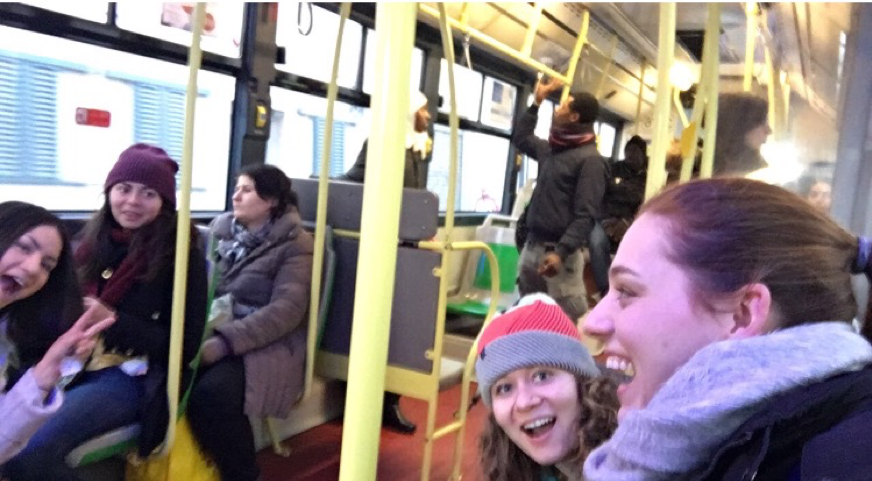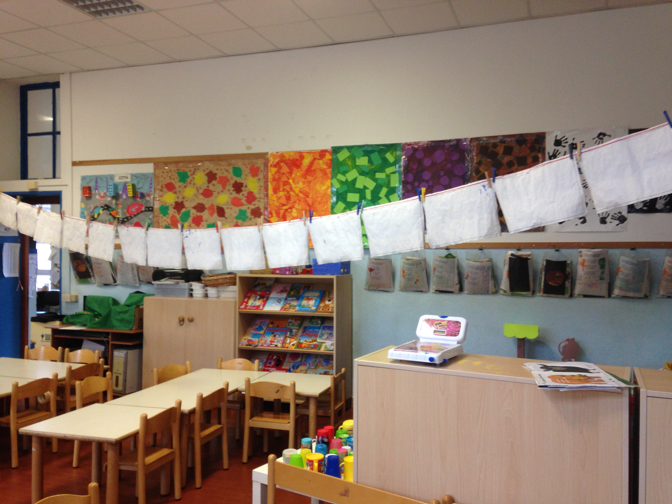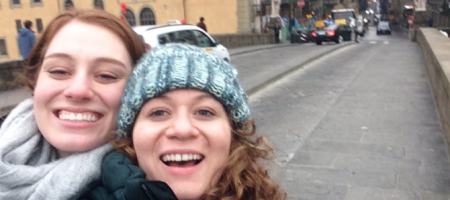Italy | Shouting Sweet Nothings
BY WILLA GIFFIN
“This is a cowslip,” I enunciated carefully, while pointing at a picture of a dainty yellow flower I’d never seen before. Muddled little third grade Italian voices attempted to repeat the new English word that I was asked to teach them. The intended response of “Cowslip” turned into a variety of similar sounding words amidst the chorus of kids (“gossip”, “colic”, “cowlick”, etc.).
“Almost!” I corrected with enthusiasm, “Cow, come una mucca” (Cow, like a cow) “e ummmmmm…. lip”. I pointed to my mouth and resorted to my go-to: English with a poor imitation of an Italian accent.
“Ohhh!!! cowsleep” the eight year olds repeated with such pride in their newly acquired, yet severely infrequently used English word.
Close enough, I thought to myself, before moving onto the next flowers’ name that I’d never heard before. “This is a Caladium”…
…
It was my first day working at an Italian elementary school that my study abroad program put me in touch with. When the day started off, I had absolutely no idea as to the kind of crash course in Italian culture that was in store for me.
That morning I had my language class, and at 12:30, when it finished, I grabbed a cappuccino and panini from Ricchi, the beloved caffè in the building adjacent to school. My internship that afternoon didn’t start until 2, but the bus ride was supposed to be lengthy and I have a knack for somehow misunderstanding even the most fool-proof GPS systems; so I ate my lunch and headed to the bus stop early.

I walked with my friend/ bus-taking consultant, Lizzy, who was assigned to the same school as I was. Lizzy is living in a home-stay towards the outer edge of Florence, so she’s had plenty of practice navigating the different lines.
After a short, beautiful walk, we waited at our bus stop and stood amidst a group of ten chic Italians that made me ever aware of how American I looked in my scuffed up gray Chuck Taylor Converse.

All of a sudden, an authoritative, official-looking man walked up from around the corner. He announced something fast, loudly, and in Italian, to the crowd gathered at the stop. The group of bus-goers let out a collective sigh, and immediately started moving in response. Uh oh. What was happening?
Lizzy and I looked at each other, each hoping that the other had understood every other word of the man’s speedy Italian. But nope. Not a lick.
Not really knowing what else to do, we decided to follow the crowd, with the hope that maybe the man had announced that our stop had been relocated for the afternoon, and therefore all the bus-goers could migrate to the new stop together.
Our plan of playing tag-along failed almost immediately as the crowd started to dwindle and the bus-goers dispersed in every possible direction. However, Lizzy and I held out hope, and followed two older women who stuck together and looked like they were well-versed Italian travelers, with their heavy fur coats and practical, yet obviously classy, leather shoes. Like undercover cops, we covertly trailed the women, assuming that they knew where they were going, and therefore would somehow lead us to where we were going as well.
Only after the fur totting women stopped directly in the middle of a street with heavy traffic in order to study a giant map, did we realize that the women we had secretly assigned to be our fearless leaders, were just as foreign and confused as we were. Following- the- Italian-looking-women, mission aborted.
Lizzy and I ended up walking on our own to the train station where we got on line 21—not without complication—but we (mostly Lizzy) figured it out.

After a 45-minute ride, we got off at our bus stop. It was raining pretty heavily and we got a little lost (yes, even with Google maps open on two different phones) but we made it to the school with one minute to spare.
We entered the building and were immediately greeted by two warm women working the school’s front desk. In quasi-Italian, we said hello and attempted to explain that we were the volunteers who were there to teach English.
Lizzy and I parted almost immediately as she was sent off to her assigned classroom. Then one of the women looked at me and motioned down the hall, “lavorerai in terza elementare”. Oh shoot. This was a verb tense I had yet to learn. And what did “terza” mean?
I asked the woman to please repeat (“ripete per favore”—my most used Italian phrase). Hearing the reiteration of unfamiliar words didn’t clarify much, but I nodded convincingly, like it did.
Ok. I could figure this out. “Terza”, probably like “terrace”… Ok. So I’ll just go upstairs whenever I find a staircase.
I went down an extremely long hallway that seemed to extend off into the abyss, but eventually I came across a staircase.
My out of shape, full-of-pasta body took me up the flight of stairs. I opened the door at the top of the staircase, only to see that I’d walked into a janitor’s closet. So nope. Terza does not mean terrace.
Still confused as to what to do next, I stood, staring into the closet at the assortment of brooms and mops and cleaning fluids. This was definitely not the classroom that I was supposed to be in.
“Ciao??” I heard from down the stairs.
I whipped around, “Ciao!” my head in a janitors closet sandwiched between two brooms, was not the way I’d expected to get introduced to the teacher I’d be working for.
Nevertheless the teacher greeted me kindly and with gratitude, and then led me into the gym where her 28 third graders were doing volleyball drills with a student teacher. Turns out “terza” means third.
She motioned for me to sit at the sidelines. I relaxed on a folding chair and observed the class dynamic.
I was immediately struck by the frequency and volume of the yells and hollers that bounced off the walls of the gym. To me, the tone of the two teachers’ scoldings sounded furious, especially when the smallest eight year old couldn’t get the ball over the net. Then again, I didn’t even know the words that were being yelled…. The teachers could have been shouting, “you, young man, are an incredible athlete!”, but maybe they were just screaming these positive affirmation very loudly and with significant aggression.
I also saw more classic Italian hand gestures, whipped out and flying around, in my first ten minutes in the gym, than during my entire month so far in Italy.
I guess I should have expected these sorts of impassioned outbursts, given the stereotypes I’ve seen in Italian movies from the yelling grandmother, stationed in the kitchen, going on fiercely about how her grandson needs to find a nice girl who can make him the lasagna he deserves.
Sitting there, thinking back to my own gangly, uncoordinated elementary school days, I couldn’t help but feel slightly rattled by these apparent scoldings. The Italian kids, however, didn’t seem to be phased even an iota. They were completely used to it, and even laughed it off.
After about a half an hour of observing surprisingly intense third grade volleyball drills and holding two tiny pairs of the students’ “occhiali” (reading glasses), the class finished their gym period. They began to line up and I joined them at the door.
A group of five girls giggled to each other, whispering behind their hands, and keeping their eyes fixated on me. With so much excitement about the new, tall, American in class, one girl, Marina, built up the courage and asked, “what is your name be?”
“My name is Willa, Mi chiamo Willa.”
“Wella” they all repeated in unison.
Asking me my name, with an extra verb at the end, seemed to be close to the only English the kids knew. My work was cut out for me, and I was excited.
Unlike most adults I’ve encountered, the kids didn’t dumb down their Italian for me, even though I clearly had a very minimal grasp on the language, but rather they spewed out Italian words at lightning speeds, erupting with rapid-fire questions.
“Sai di Hollywood?” (Are you from Hollywood), “Ti Piace i Lakers” (Do you like the Lakers?) “Hai incontrato Michael Jackson?” (Have you met Michael Jackson?) “Ti piace gelato alla vaniglia?” (Do you like vanilla ice cream?) etc.
One little girl asked me, “Da quanto tempo sei stato in un aereo dagli Stati Uniti a qui?” (How long were you in an airplane to go from America to here?) Feeling an irrationally strong urge to fit in amongst the group of eight year olds, I got a little flustered and attempted to answer her question quickly, like it didn’t even take me any thought. I rattled off, “14 anni”, to convey 14 hours. I felt cool, like I had carved out my spot in the in-crowd, until I noticed the completely appalled look on the little girl’s face. It then dawned on me that although I meant to say “14 ore” (hours), instead, I said 14 years! I had just convinced a little girl that I had spent more than half of my life on an airplane and she probably thought I was an alien.

After everyone changed out of their gym clothes, we walked to class, accompanied by more yelling. When we reached the room the kids took their seats, and there was some more yelling.
The teacher, who was very kind and gentle to me, explained that I would be going over English translations of flower names to half of the students at a time, while she took the other half outside to eat lunch, and then we would switch groups after an hour. (The school day here is from 8-4:30…).
I looked through the list of English flower names that I would be teaching and didn’t recognize half of the words. I felt slightly confused as to why I was teaching these kids who could just barely ask me my name, words such as “cowslip”, “cornflower”, and “larkspur, but I wasn’t about to suggest otherwise and risk getting yelled at. I would cry.
We went down the list of flowers, projecting their images on the wall, and writing out the Italian names and their English equivalents. Each kid then decided which flower he or she liked the most, and made a labeled drawing of it.
I walked around the class and looked at their magnificent artwork. I alternated between saying “bravo” and “brava”, all the while wishing I had a wider repertoire of Italian compliments.
While maybe slightly frustrating at first, it was so nice trying to communicate with the kids, with only a few shared words, and many smiles.
When everyone finished their drawings, the other half of the class came in from lunch. I did the same floral exercise with the new group.
At 4:25 the teacher lead the remainder of the first group of students back inside the classroom. She carried a tub of apples and gave them out to each student. She hugged each kid goodbye and kissed them on the forehead.
Then, everyone lined up by the door in order to meet their parents at the school’s entrance and go home for the evening.
As we all walked out of the class, Marina grabbed hold of my hand, and held it tightly. She looked up at me with beaming eyes and an enormous smile, “Quando tornerai?” (When will you return).
I think I told her one week, but I might have said one century.
Willa Giffin studied abroad in Florence, Italy in Winter 2017: http://eap.ucop.edu/OurPrograms/italy/Pages/language_culture_florence_quarter.aspx



